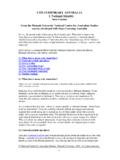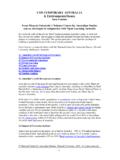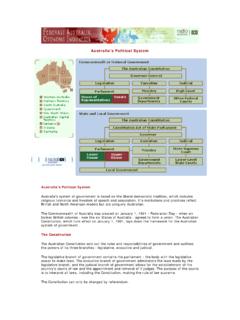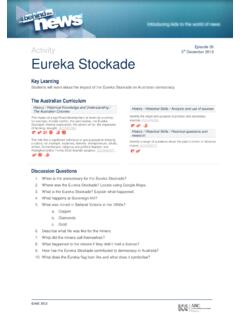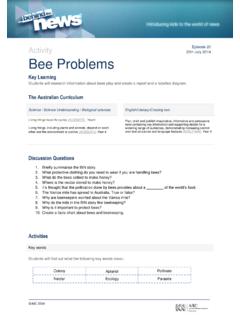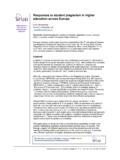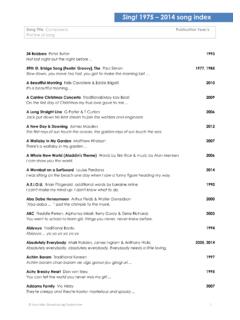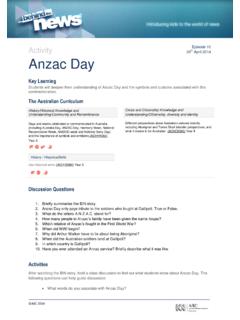Transcription of Lesson 3 - Investigating Eyesight
1 Lesson 3 Investigating Eyesight Page 1 2004 Ruben Meerman, ABC Science Investigating Eyesight Lesson 3: Activities and optical illusions Brief description Students work through a series of activities to explore their sense of sight . They experience their eyes blind spots (where the optic nerve enters the eye), learn to see a stereoscopic 3D cube and discover their dominant eye. They learn to appreciate the brain s role in vision and enjoy some famous optical illusions. This Lesson also presents opportunities to discuss learning styles. Duration: 60 minutes Year Level: Middle to upper primary Topics: The senses, Vision, Optical Illusions Preparation: 10 minutes Overview Whole class Discuss activities (2 3 min) You could begin by showing one or two of the optical illusions in the student worksheet on the OHP.
2 You could also discuss where our sense of sight comes from (ie is it just our eyes?) Small groups Activities (small groups or individually) (45 min) Whole class Discuss activities (5 - 10 min) Equipment and preparation y Download and photocopy 30 student worksheets Objectives Students prior knowledge No prior knowledge is assumed for this Lesson . Science concepts Students discover and understand: y the brain and eyes work together to give us our sense of sight y the eye has a natural blind spot where the optic nerve exits through the retina y the brain compensates for the eye s natural blind spot y most people have a dominant eye y we learn to use our sense of sight from the moment we are born y the brain is excellent at remembering visual information / continued .. Lesson 3 Investigating Eyesight Page 2 2004 Ruben Meerman, ABC Science Objectives continued .. Positive attitudes Students will: y appreciate that we all learn differently y appreciate that we all take different amounts of time to learn y appreciate that learning is a complicated process which involves all the senses Procedure Introduction (Whole class / 5 10 min) y OHP Demonstrations y Distribute worksheets Activities (Individual or small groups / 30 45 min) y Students can do each activity individually, with a partner or in small groups.
3 Y You may could stop to discuss each activity individually or wait until all activities have been completed. y Each activity is quite interesting, so students may be excited about discussing them with each other. Early finishers y Early finishers could do further internet research if computers are available. Several websites are listed in the student worksheet. Conclusion (Whole class / 10 15 min) Class discussion y The class discussion presents opportunities to relate the activities to general learning. You could lead the discussion by asking questions such as: how many people found that they are right eye dominant? how many are also right handed? how many people found they are left eye dominant how many have no eye dominance? will it help you to know which eye is dominant? who saw the cow in the photo immediately? Who saw it after reading the clue? do you think seeing the cow has anything to do with being more intelligent?
4 Do you think learning how to see the word why is the same as learning how to read? - or learning mathematics? Plan next science Lesson y Ask students to collect and bring in any household items you might require for the next Lesson you have planned Lesson 3 Investigating Eyesight Page 3 2004 Ruben Meerman, ABC Science Teacher notes The human eye Descriptions: Iris front part of the choroid, usually blue, green or brown in colour Pupil black circle in middle of the iris through which light enters the eye Cornea bulged, clear part of the sclera in front of the lens Sclera tough outermost layer of the eye which is mostly white (the cornea is the clear part of the sclera) Choroid second layer of the eye, contains blood vessels, iris and muscles attached to the lens which cause if to change shape for focussing Retina innermost layer of the eye contains cells called rods and cones which are sensitive to light Cones light sensitive cells responsible for colour vision and seeing detail Rods light sensitive cells responsible for vision in low light Macula small sensitive region in the centre of the back of the retina this is where you see an object when you are looking directly at it the very centre of the macula, called the fovea, is where you see the finest detail Optic disk where the optic nerve and blood supply enter the eye there are no rods or cones in this part of the retina so it is a blind spot Further reading and colour diagrams: How Stuff Works (How Vision Works) page.
5 Eyelid Pupil Sclera Cornea Iris Lens Vitreos humor (clear, gel-like liquid) Retina Optic nerve Macula Optic Disk Choroid Lesson 3 Investigating Eyesight Page 4 2004 Ruben Meerman, ABC Science Activity 1 & 2 The blind spot The optic disk is a blind spot because it does not contain any rod or cone cells (the light sensitive cells on the retina). Looking at the cross focuses it onto the macula. The image of the circle disappears from view when its image is focused onto the optic disk. This happens at a distance which depends on the separation between the cross and the circle, and the distance between the macula and the optic disk. We don t notice the blind spot in our field of vision because the brain fills in the blanks . Drawing a line through the cross and circle helps demonstrate that the brain can do this for each eye individually. The figure below is a simplified illustration of the images being projected onto the retina.
6 A) Too far: you can see the circle because it is focused on the retina b) Just right: the circle is focussed on the optic disk (blind spot) and disappears c) Too far away: the circle is focussed on the retina again and the the circle re-appears An excellent account Activity 3 After images Each rod and cone cell in the retina contains a light sensitive chemical called rhodopsin. When light hits a rhodopsin molecule, it changes and releases a tiny amount of electrical energy. This energy travels along a nerve to the brain. The brain receives and assembles electrical signals from each rod and cone. More light converts more rhodopsin within the cell resulting in a stronger electrical signal to the brain. Once a rhodopsin molecule has changed and released its electrical energy, it is converted back to rhodopsin via a number of chemical reactions inside the cell.
7 The eye s amazing ability to adapt to a huge range of light levels is achieved by a second chemical called arrestin. Arrestin slows down the rate at which of the chemical reactions that lead back to rhodopsin. Arrestin is released when lots of light is entering the eye and converting lots of rhodopsin. In bright light, arrestin reduces the strength of the signal the cell sends to the brain. In darkness, very little or no arrestin is released to make each cell more sensitive to light. We see a bright after image of the dark ring because the cells which saw it were behaving as though they were in darkness. All the arrestin in those cells gets used up and the cell becomes more sensitive to light. By looking at a plain white image, that part of the retina continues to send stronger signals for a while, until enough arrestin is present inside each cell to desensitise them. macula optic nerve optic disk Lesson 3 Investigating Eyesight Page 5 2004 Ruben Meerman, ABC Science Activity 4 Seeing in 3D The stereoscopic image provided is two views of the same cube.
8 The left cube is what the right eye would see and vice versa. Not everyone can manage to fuse these two images. It requires the ability to cross, or de-couple the eyes. With practice, people who can do it usually get better. 3D Cinemas 3D cinemas project two separate images onto one screen. One is the left eye s view, the other is the right eye s view. Viewers need to wear special glasses so that the left eye only sees the left eye s view and vice versa. One way to do this is to pass the left eye s image through a red filter (a bit like red cellophane) before projecting it. By wearing a red filter over the left eye, only red light can enter. If the right eye s image is projected through a blue or green filter, it won t pass through the red filter and vice versa. Most 3D cinemas now use polarising filters which do not affect the colour of the projected images. The polarisation is set differently for each eye s image and the glasses are also polarised.
9 You can see how polarisation blocks light by holding two pairs of polarised glasses in front of one eye and rotating one pair of glasses while holding the other still. Activity 5 Dominant eye Most people have a dominant eye. It is the one that the brain takes most notice of when both eyes are open. Not everyone has a dominant eye. 80% are right eye dominant, 10% are left eye dominant, and 10% have no dominance. Eye dominance is not related to hand dominance, but because most people are right handed, being right eye and right hand dominant is common. Websites Depth Spinner: an optical illusion created by the motion of a spinning spiral which makes your hand appear to swirl after staring at this animated disk: Human motion perception: An amazing animation. Use only five white dots on a black background representing the head, hands and toes, to perceive a human being walking: Vision: An excellent reference about how the eye works: Insect eyes: Electron microscope photos of insect eyes: Investigating Eyesight Student Worksheet Page 1 2004 Ruben Meerman, ABC Science Investigating your Sense of sight Name _____ Activity 1 Find your blind spot Most people aren t aware that each of their eyes has a blind spot.
10 This is because you are not normally aware of it. In this activity, you will use a very simple method to find your blind spot. Once you have seen that there really is a blind spot, you will learn why it is there. Materials required: Black pen or marker, Ruler, Blank white paper (half sheet of A4) What to do 1. Fold the paper in half along the short edge and draw a black cross and a solid black circle as illustrated. The circle and cross should be about 1cm wide and roughly 7cm apart. 2. Hold the ruler in front of your nose a little. Hold the paper at the end of the ruler so that the cross is on the right hand side. 3. Keep your right eye closed or covered and look at the paper with your left eye. 4. Look directly at the cross with your left eye and slowly move the paper towards your face. Take notice of what happens to the circle as you do this, but keep looking directly at the cross. At a certain distance, the dot will disappear from view.
